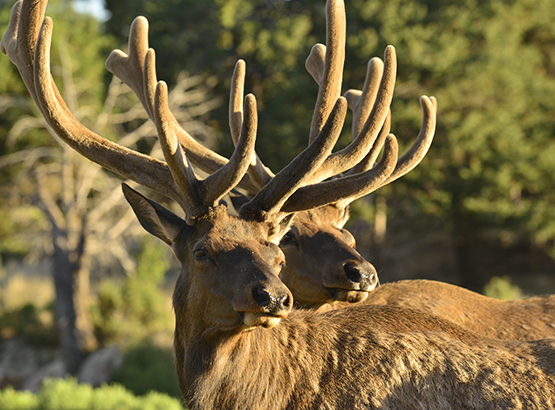Elk
Elk were at one time the most widely distributed member of the deer family in North America – found everywhere except the Great Basin desert and the Southern coastal plains. Their population was estimated to total 10 million before European man arrived. Elk withstood the impacts of the western settlement better than the buffalo because they inhabited rougher terrain.

About
The great reduction in elk numbers is attributable to market hunting and agriculture. The population low of 90,000 occurred in 1922, of these, 40,000 were in Yellowstone Park. The Park’s herds became a reservoir for stocking breeding elk. Between 1912 and 1967 more than 13,500 elk were transplanted from the Park. In February 1913, 83 elk were released in Cabin Draw near Chevelon Creek. From these transplants, the Arizona elk population has grown to nearly 35,000 animals.
Interesting fact: Antler development is a function of age. The antler cast occurs in January to March for adult bulls and from March through May for sub-adults. New growth occurs shortly after the cast. The growing period ranges from 90 days for yearlings to 150 days for adult bulls. Therefore it’s possible to see yearlings with old spikes at the same time as bulls with a foot of velvet.
Hunt History
Because of World War II, no season was conducted in 1944 or 1945, but a limited hunt, which included the issuance of the first cow elk permits, was again authorized in 1946. Elk hunting opportunities expanded almost annually as biologists and ranchers feared that Arizona’s elk population might now “rise out of control.” These concerns culminated in 1953 when 6,288 permits were issued and 1,558 elk were taken-more than 1,000 of which were cows. Because of concerns about the “slaughter,” elk permits were greatly curtailed in 1954 and remained below 5,000 until 1965, when more than 6,000 permits were again authorized. By 1967, elk permit numbers were exceeding 7,000, and the annual harvest exceeded 1,500 elk. Once again, elk permits were gradually lowered; although new hunts, including archery hunts, were being initiated.

Our Mission
To conserve Arizona’s diverse wildlife resources and manage for safe, compatible outdoor recreation opportunities for current and future generations.
Hunt Regulations
Rules and regulations for hunting in Arizona.
Regulations for spring hunts, fall hunts and pronghorn, elk hunts.
